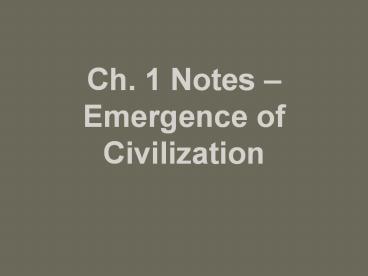Ch. 1 Notes - PowerPoint PPT Presentation
1 / 31
Title:
Ch. 1 Notes
Description:
Ch. 1 Notes Emergence of Civilization – PowerPoint PPT presentation
Number of Views:93
Avg rating:3.0/5.0
Title: Ch. 1 Notes
1
Ch. 1 Notes Emergence of Civilization
2
Mind Mapping Effective Note Tool
3
(No Transcript)
4
(No Transcript)
5
(No Transcript)
6
Section 1 Human Origins in Africa
7
Scientists Search for Human Origins
- Defining Prehistory
- Time before invention of writing, about 5,000
years ago - Scientific Clues
- Archaeologists study bones and artifacts human
made objects - Anthropologists study culture a groups way of
life - Paleontologists study fossils plant and animal
remains preserved in rock
8
Class Activity
- What does an anthropologist study?
- They help explain demographics (societies age,
income/wealth, education, and other
characteristics of that society) - How?
9
Scientists Search for Human Origins cont.
- Early Footprints Found
- Mary Leakey team discovers prehistoric footprints
in Tanzania in 1978 - Laetoli footprints belong to hominids creatures
that walk upright - The Discovery of Lucy
- Donald Johanson team finds female hominid in
Ethiopia in 1974 - Nicknames 3.5 million-year-old skeleton Lucy
- Hominids Walk Upright
- Walking upright helps hominids travel distances
easily - They also develop the opposable thumb
- Early hominids, like Lucy, are a species of
australopithecines
10
Donald Johanson with Lucy
11
Lucy
12
The Old Stone Age Begins
- 2 Phases of the Stone Age
- Paleolithic Age (Old Stone Age) lasted from about
2.5 million to 8000 B.C. (Before Christ) - Neolithic Age (New Stone Age) lasted from 8000 to
3000 BCE (Before Current Era) - Paleolithic Age had cold temperatures and large
glaciers (Ice Age) - Use of tools, fire, and language develops during
the Stone Age
13
The Old Stone Age Begins cont.
- Homo habilis may have used tools
- Louis and Mary Leakey discover 2.5
million-year-old hominid fossil - Found in Tanzania, is named Homo habilis man of
skill
14
The Old Stone Age Begins cont.
- Homo erectus Develops Technology
- Appeared about 1.6 million years ago in East
Africa - Homo erectus, upright man, used intelligence to
develop technology - Technology ways of applying knowledge, tools,
and inventions - Developed tools to dig, scrape, cut became
skillful hunters - First hominid to use fire might have developed
language - First hominid to migrate from Africa moved to
Asia and Europe
15
Homo Erectus
16
The Dawn of Modern Humans
- Appearance of Homo sapiens
- Species name for modern humans had larger brain
than Homo erectus - Neanderthals and Cro-Magnons appear Neanderthals
are not ancestors of Homo sapiens - Neanderthals Way of Life
- Powerful muscles and thick bones
- Lived 200,000 to 30,000 years ago in Europe and
SW Asia - Developed religious beliefs and performed rituals
- Lived in caves, shelters made of wood and skin
17
Neanderthal Images
What they are saying now?
18
Neanderthal Images
Cave Painting in France
19
The Dawn of Modern Humans cont.
- Cro-Magnons Emerge
- About 40,000 years ago Cro-Magnons appear
- Physically identical to modern humans
- Hunted in groups better hunters than
Neanderthals - Advanced skill in spoken language
- Migrated from North Africa to Europe and Asia
- Population grew quickly replaced Neanderthals
20
Cro-Magnons
CLOSELY RELATED TO TODAY TO PEOPLE FROM FINLAND
21
Section 2 Humans Try to Control Nature
22
The Beginnings of Agriculture
- The Neolithic Revolution
- Neolithic Revolution agricultural revolution,
began about 10,000 years ago - Nomadic women scattered seeds, then discovered
crops - Shift from food-gathering to food-production
great breakthrough - Causes
- Rising temperatures longer growing seasons
- Constant supply of fresh food equals population
growth
23
The Beginnings of Agriculture cont.
- Early Methods
- Slash-and-burn farming- clear land by cutting and
burning trees - Moved after a couple of years
- Domestication of Animals
- Domestication taming wild animals for food
- Tamed horses, dogs, goats and pigs
- Example Jarmo in Iraq and Catal Huyuk (chuh-TUL
hoo-Yook) in Turkey
24
Catal Huyuk
25
Catal Huyuk
26
Section 3 Civilization
27
Villages Grow Into Cities
- Farming leads to larger communities
- Food surpluses allow people to develop new skills
- Invention of wheel and sail key
- Social classes develop
28
How Civilization Develops
- Advanced Cities
- Centralization planning become focused on a
certain area. - Bureaucracy Government workers/leaders.
- Specialized Workers
- - Division of Labor -
- Complex Institutions
- Example Temples Ziggurat is a pyramid shaped
monument - Theocracy governments ruled by religious
leaders - Record Keeping
- Advanced Technology
- Example in book is Ur in Iraq
29
Pictures of Ur
The Great Ziggurat
Tombs
30
UR
31
Class Activity
- The U.S. is an advanced civilization. With a
partner, come up with 2 examples of each
characteristic of a civilization.































